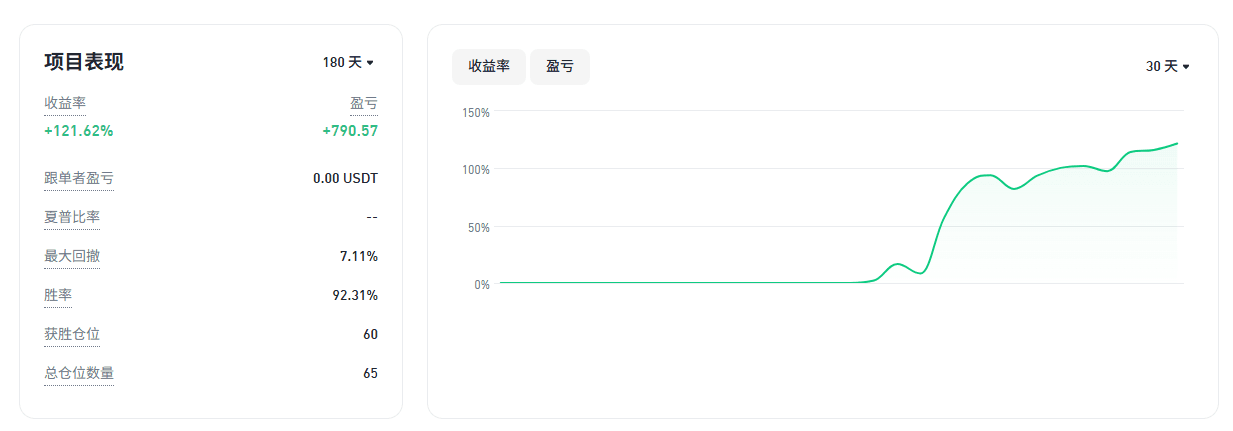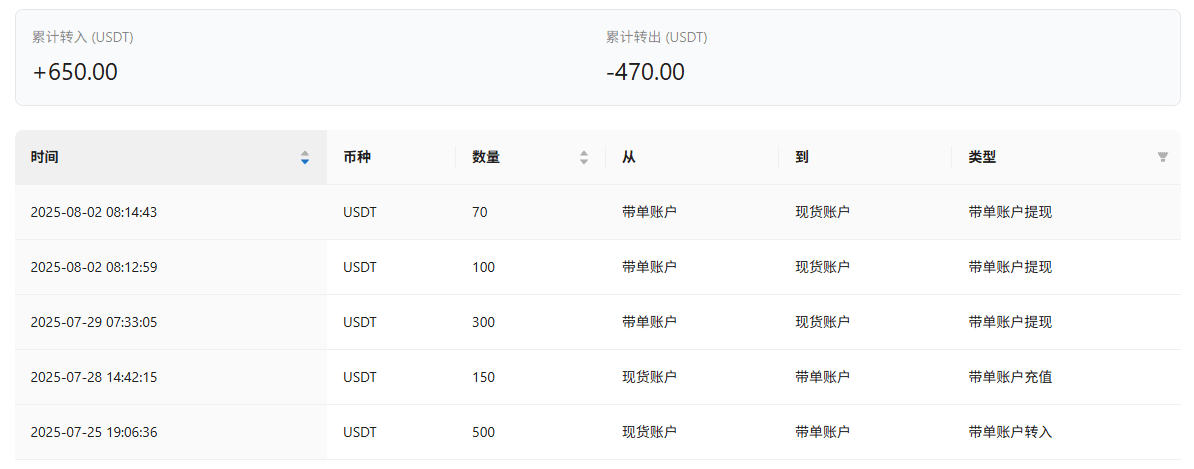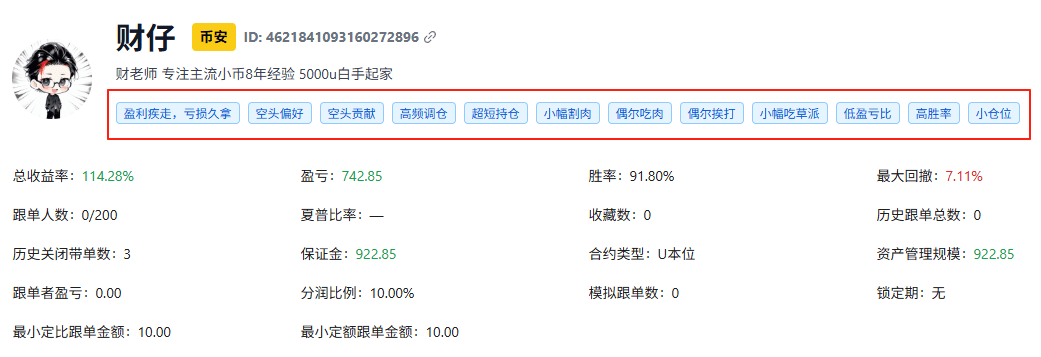Only look at the data, don't talk about feelings.
Interpreting the lead trader is mainly through dismantling and analyzing the lead trader's actual trading performance and trading data, helping followers understand the following trading model and better familiarize themselves with the lead trader's trading habits and preferences; it does not constitute any investment advice, and attempts to interpret objectively.
Interpreting the Lead Trader @财仔

Background: Following the financial master is also due to being a veteran of the lead trading community, having started leading trades on Binance for at least a year and a half. In July of this year, I noticed they were still leading trades normally, and now looking back, oh, they are back at it again? What's going on, I need to see.
Core Data Interpretation
Let's first look at the overall core data as usual.
#ROI: The 180-day return rate is 97.85% (the report was generated about two days ago, and it has continued to rise in the past two days). Although it is 180 days, due to it being the third restart, this data only represents the return rate of this position.
Scale of Follow Trading: The new round of follow trading scale has not yet effectively taken off, currently only less than 1000U, with a relatively small scale and weaker risk resistance.

Overview of the Third Round of Follow Trading Data Follower: No current followers.
Sharpe Ratio: No data available.
Win Rate: The nominal win rate is as high as 90%+, but this high win rate may be achieved through quickly taking profits from small positions, which can be somewhat misleading.
Key Contradiction Point: The data at the current stage is not representative, so upcoming data will focus on evaluating previous historical trades for simple analysis.
Profit and Loss Performance
Initial Funds: The initial margin for this restart is 500, with an additional 150U added later. Based on its operations, it seems that when its account margin exceeds about 1000U, it will withdraw funds. The current withdrawal amount is gradually approaching its initial investment;

Capital Flow in the Lead Trading Account Win Rate: 89.66%, but its profit structure has significant issues.
First, let's look at the operation records since this restart. As of the report generation, there have been a total of 87 operations, with 77 profitable trades, which aligns with its current win rate and an average profit of 15.34 per trade, with a maximum profit of 185.35; there were 35 losses, with an average loss of 35 and a maximum loss of 117; the average loss per trade is at least 2.28 times the average profit per trade.
Considering its previous historical operations, there have been a total of 157 profitable trades and 45 loss trades, with an average profit of 4.57 and an average loss of 13.43. The average loss per trade is at least 2.94 times the average profit per trade.
This is a typical model of 'more wins but fewer losses (in terms of count), but big losses and small profits (in terms of amount)'. The high win rate is achieved by quickly harvesting small profits, but once a loss occurs, its amount is often much larger than the single profit.
Trading Preferences
Preference Direction (Long/Short): In over 200 trades, short trades account for 68.3%, indicating the trader's extreme preference for profiting from market declines, and their trading system or judgment logic is highly inclined towards bearish markets.

Analysis of Lead Trader's Trading Preferences and Behavior Habits Preferred Coins: 37.62% of mainstream coins (BTC, ETH) make up the foundation of the assets, but they are not the primary trading targets. Altcoins account for over 60%, with a clear focus on higher volatility and greater risk. This trader claims to be 'focused on small mainstream coins', and the data corroborates that;
Holding Time: The longest held order is close to 8-9 days, the shortest is 19 seconds, and the average holding time is close to 6 hours; based on the historical trading data of over 200 positions, nearly 92% of the orders can be completed within 24 hours, aligning with their high-frequency short-term style. However, the longest holding record presents a stark contrast to the average holding time. This abnormal data usually indicates that the trader is unwilling to stop losses after an order incurs a loss, instead passively extending the holding period. Furthermore, there are still instances of holding positions in current trading positions.
Core Behavior: Holding Positions
'Holding positions' is the behavior pattern that this trader needs to be most wary of. When the trading direction is contrary to the market trend, they do not choose to stop loss but rather hold the losing position, waiting for a price rebound.

On July 15th, the ETH short position was held for nearly 9 days, far exceeding its average holding level. During the holding period, the price continued to move in an unfavorable direction, ultimately leading to huge losses.
As of the report generation, the short positions of VINE on July 27th and IOTX on July 31st have been held for over 9 days and 5 days respectively, both in significant loss states. Their 'partial liquidation' status may indicate that the trader made position adjustments during the process, but did not choose to fully liquidate to stop losses, still waiting for the market to turn.
Whether in the historical records of closed positions or the currently held positions, they clearly point to this trader's habit of 'not stopping losses, stubbornly holding losses'. This is the highest risk element in their strategy.
Risk Attention
Black Swan Risk: There is a risk of significant account asset drawdown due to huge losses from a single trade. (The historical trade of 604.32 is direct evidence.)
'Holding positions' strategy risk: Following a trader who has a habit of 'holding positions' is extremely dangerous. If the follower's margin is insufficient or leverage is too high, they are likely to be forcibly liquidated (blown out) in extreme market conditions, while the lead trader may escape due to their capital advantage.
High Volatility Risk of Altcoins: The trading targets are concentrated on altcoins. Although this may yield high returns, their price volatility is severe, and the risks are much higher than those of mainstream coins.

Core Views and Follow Trade Suggestions
High-frequency short-term trading, inflated win rate: This trader exhibits typical high-frequency short-term trading characteristics, with the actual profit model relying on multiple small profits but bearing the risk of a single huge loss.
'Holding positions' behavior: The trading records clearly show that this trader tends to extend the holding period in the face of losses, waiting for a market reversal (commonly known as 'holding positions') rather than stopping losses in a timely manner.
Imbalance in Profit-Loss Ratio: The single largest loss (-604.32 U) far exceeds the maximum profit (185.35 U), indicating serious flaws in their risk control system.
Short Selling Preference: Trading behavior clearly shows a preference for short selling.
For followers, following this lead trader requires a high level of risk awareness, and an independent stop-loss strategy must be set to avoid significant drawdowns of capital or even liquidation risks due to their 'holding positions' behavior.
Follow Trade Suggestions
Position Control: Given its characteristics of 'holding positions' and 'imbalanced profit-loss ratios', it is not recommended to use large amounts of capital for following trades.
Stop Loss: In the following trade settings, an independent and reasonable stop-loss price or ratio must be set for each order. This can effectively help you avoid unlimited losses caused by the lead trader 'holding positions'.
Mindset: Do not be misled by its high win rate of 89%. One loss can wipe out dozens of profits. Be mentally and financially prepared for possible sudden and significant drawdowns.
The above analysis was conducted by WolfDAO (x: @10xwolfdao) through data collection and comprehensive analysis, with screenshots sourced from the WolfDAO follow trading assistant, and does not constitute actual investment advice.
The community has been opened (https://t.me/wolfinsights) and friends are welcome to join the discussion. If you have any lead trader analyses you would like to see, feel free to let us know in the comments (the follow trading tool is currently in a trial experience, join the group to receive a free experience code).
If you find the content quite good, don't forget to follow us! Feel free to support the author with a three-click action (like, comment, share).
